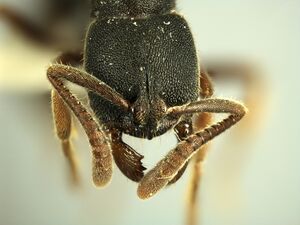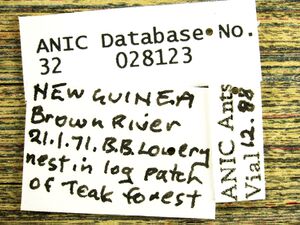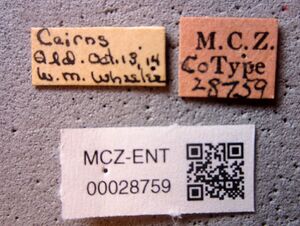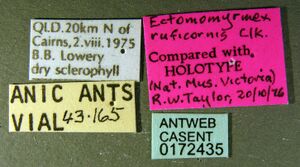Ectomomyrmex ruficornis
| Ectomomyrmex ruficornis | |
|---|---|

| |
| Scientific classification | |
| Kingdom: | Animalia |
| Phylum: | Arthropoda |
| Class: | Insecta |
| Order: | Hymenoptera |
| Family: | Formicidae |
| Subfamily: | Ponerinae |
| Tribe: | Ponerini |
| Genus: | Ectomomyrmex |
| Species: | E. ruficornis |
| Binomial name | |
| Ectomomyrmex ruficornis Clark, 1934 | |
Identification
Keys including this Species
Distribution
Latitudinal Distribution Pattern
Latitudinal Range: -7.199999809° to -16.885872°.
| North Temperate |
North Subtropical |
Tropical | South Subtropical |
South Temperate |
- Source: AntMaps
Distribution based on Regional Taxon Lists
Australasian Region: Australia (type locality).
Indo-Australian Region: Indonesia, New Guinea.
Distribution based on AntMaps
Distribution based on AntWeb specimens
Check data from AntWeb
Countries Occupied
| Number of countries occupied by this species based on AntWiki Regional Taxon Lists. In general, fewer countries occupied indicates a narrower range, while more countries indicates a more widespread species. |

|
Estimated Abundance
| Relative abundance based on number of AntMaps records per species (this species within the purple bar). Fewer records (to the left) indicates a less abundant/encountered species while more records (to the right) indicates more abundant/encountered species. |

|
Biology
Castes
       
| |
| . | Owned by Museum of Comparative Zoology. |
Images from AntWeb
  
| |
| Worker. Specimen code casent0172435. Photographer April Nobile, uploaded by California Academy of Sciences. | Owned by ANIC, Canberra, Australia. |
Nomenclature
The following information is derived from Barry Bolton's Online Catalogue of the Ants of the World.
- ruficornis. Ectomomyrmex ruficornis Clark, 1934b: 31, pl. 2, fig. 14 (w.) AUSTRALIA. Combination in Pachycondyla: Brown, in Bolton, 1995b: 309; in Ectomomyrmex: Schmidt & Shattuck, 2014: 193.
Type Material
- Holotype, worker, Cairns, Queensland, Australia, Museum Victoria, Melbourne.
- Paratype, 1 worker, Cairns, Queensland, Australia, 13 October 1914, W.M. Wheeler, MCZC Type 28759, Museum of Comparative Zoology.
Description
References
- Brown, W. L., Jr. 1995a. [Untitled. Taxonomic changes in Pachycondyla attributed to Brown.] Pp. 302-311 in: Bolton, B. A new general catalogue of the ants of the world. Cambridge, Mass.: Harvard University Press, 504 pp. (page 309, combination in Pachycondyla)
- Clark, J. 1934b. New Australian ants. Mem. Natl. Mus. Vic. 8: 21-47 (page 31, pl. 2, fig. 14 worker described)
- Schmidt, C.A. & Shattuck, S.O. 2014. The higher classification of the ant subfamily Ponerinae (Hymenoptera: Formicidae), with a review of ponerine ecology and behavior. Zootaxa 3817, 1–242 (doi:10.11646/zootaxa.3817.1.1).
References based on Global Ant Biodiversity Informatics
- Andersen A. N., M. Houadria, M. Berman, and M. van der Geest. Rainforest ants of the Tiwi Islands: a remarkable centr of endemism in Australia's monsoonal tropics. Insectes Sociaux 59: 433-441.
- CSIRO Collection
- Janda M., G. D. Alpert, M. L. Borowiec, E. P. Economo, P. Klimes, E. Sarnat, and S. O. Shattuck. 2011. Cheklist of ants described and recorded from New Guinea and associated islands. Available on http://www.newguineants.org/. Accessed on 24th Feb. 2011.
- Snelling R. R. 1998. Insect Part 1: The social Hymenoptera. In Mack A. L. (Ed.) A Biological Assessment of the Lakekamu Basin, Papua New Guinea, RAP 9. 189 ppages

